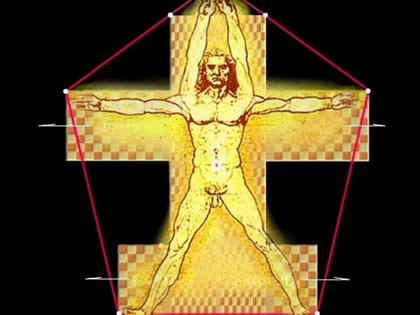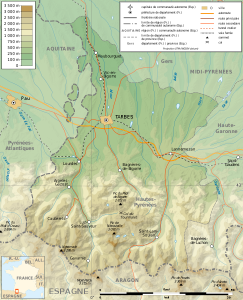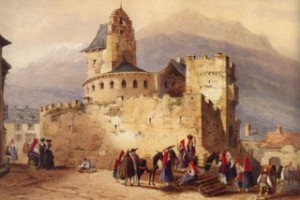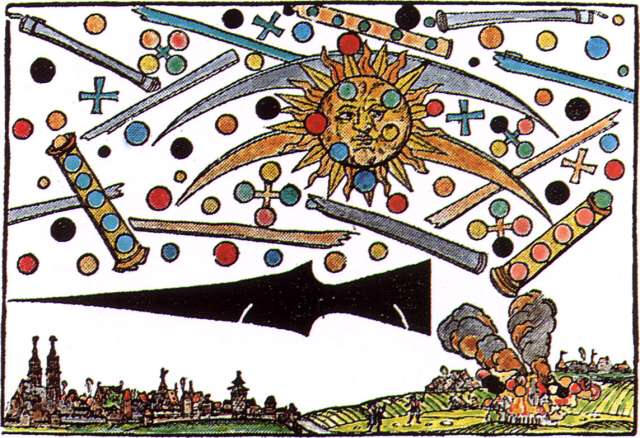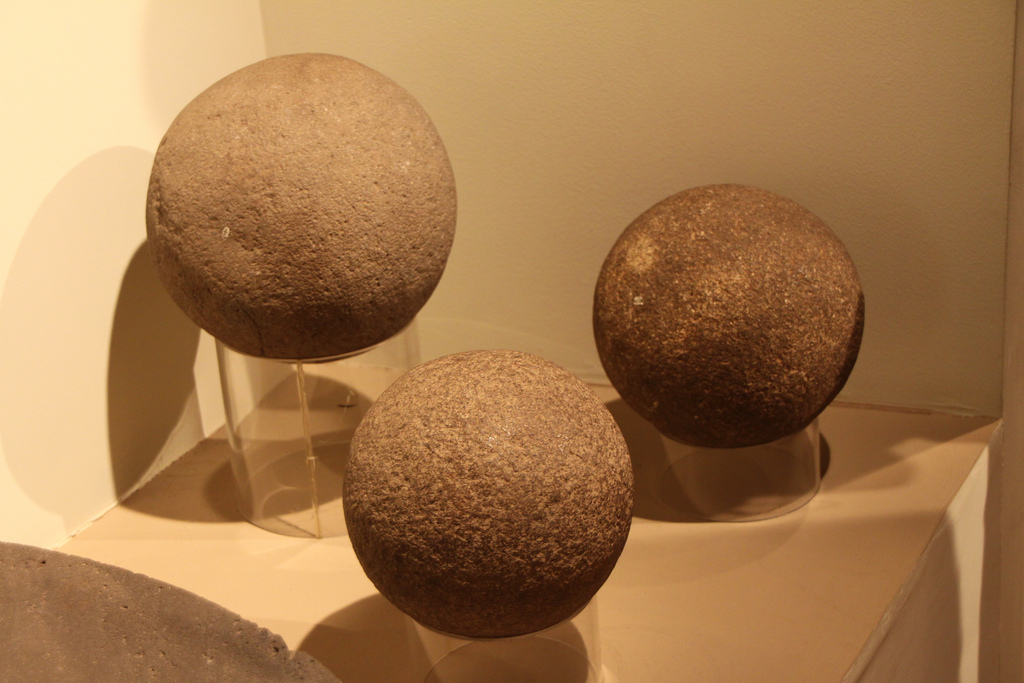|
|
Post by Goldenfleeced on Oct 15, 2013 19:46:03 GMT
I decided to start this thread, because I found some really interesting information that would seem to connect a very old legend, of a 'goose-footed' queen with another old relic... the Cross of Hendaye. We know that the Cross of Hendaye has been tied to the Rosicrucians, and possibly even the Templars, but why? What would serve to make such a connection? If we can tie the Templars to the Priory of Sion, then I think that I may have one... at least. The legend of the 'goose-footed queen' (or bird-footed queen), who is also known as La Reine Pedauque, has been connected historically to the Queen of Saba (Sheba)as well as Bertrada 'Berthe au Grand Pied' de Laon, reine des Francs (727 - 783), which also gives us a really nice hook-up to the Kings of Leon... lol... I'm only half-kidding, there. Anyway, there seems to be yet another connection that might be made, and that looks like actually was made, by one of the former Grand Masters of the Priory of Sion... Victor Hugo. Now, as far as the 'goose-footed' or (bird-footed, and this is significant, in light of the area that we are going to visit) queen is concerned, I have found at least a picture, that is interesting...  Notice the feet under the robe of the queen, at the end...
This magnificent portal [of St. Bénigne at Dijon] no longer exists, but Dom Plancher has fortunately preserved a sketch of it… The Christ in Majesty of the tympanum, the elders of the Apocalypse one above the other in the archivolts, and the statues placed against columns connect the work with the school born of Chartres. However, some originality is mixed with imitation. Beside St. Peter and St. Paul, there are two very meaningful statues: one represents Moses with the horns of light and the Tables of the Law; the other, the high priest Aaron wearing priestly garb. Aaron resembles a bishop and this is what he was imagined to be by the Middle Ages. Thus, Moses and Aaron, symbols of the Synagogue, were placed in correspondence with St. Peter and St. Paul, symbols of the Church,a perfect expression of the continuity of the two Laws. The decoration of the portal is completed by ststues of three Old Testament kings and one queen. This time the mysterious queen reveals her identity. Studying the sketch of the figure, one detail is observed that would seem incredible were there not ancient testimony to confirm it: the queen of the St. Bénigne portal was goose-footed: the Dijon artist had represented the famous Reine Pédauque, who was none other than the Queen of Sheba...
There can be no doubt that the goose-footed queen of the Dijon portal represented the Queen of Sheba. It becomes no less certain that the facing statue of a king was Solomon; and no doubt it was David who accompanied them. Why had the Queen of Sheba been placed in the company of the heroes of the Old Law and the Apostles of the New? Because, according to mediaeval doctrine, she symbolized the pagan world’s coming to Christ, and prefigured the Magi who also were searching for the true God. The Journey and Adoration of the Magi were also represented on the lintel of St. Bénigne..." www.null-entropy.com/2012/11/goose-footed-queen-of-sheba-at-dijon/Why, indeed... it would seem that the 'goose-footed queen' represents a bridge, of sorts, between two 'worlds,' so to speak... an old world, and a new... and the Templars were extremely interested in this 'new world.' As were/are the Priory of Sion... and the Rosicrucians... As far as the 'goose' and Freemasonry goes, the phrase dividers les jar means 'to spin the ganders,' or to speak the argot,- the secret language of the builders fraternities... and here, we have the beginnings of our own 'spin doctors'... lol...  |
|
|
|
Post by Goldenfleeced on Oct 15, 2013 20:12:48 GMT
Now, we have seen that the 'goose-foot queen,' La Reine Pedauque, has several interesting connections... not the least of which is her connection to the 'goose' itself, which is said to represent the Ibis... the bird sacred to Isis. This would give her a connection also to the Black Madonna, or Virgin, which is said to represent Isis as well, as well as a connection to the place where the 'goose' is very much at home... the Pyrenees mountains of northern Spain, and France. Interestingly, the Pyrenees Mountains are also home to the oldest known (and least understood) of the human languages... the L'angue d'oc,or 'language of the birds' of the Basques. Bird-footed queen, remember? Of further interest, then, is the trip that Victor Hugo made to this area of the Pyrenees in 1843 to visit the 'citadel of the Templars'... You see the map? Hugo described this area, the 'Hautes Pyrenees,' as shaped like a goose-foot... coincidentally. Although Hugo like many of the Romantic poets tended to give the landscape human or animal attributes the use of the expression patte d’oie is interesting because the symbol of a goose’s foot has a special significance in that area of France.
The «cagots» or «chrestias»[1] who lived in the area as a race apart were forced to wear a goose foot symbol made of red cloth on the shoulder. They were virtually completely excluded from the rest of French society. They had to live outside the villages, could only follow certain occupations, were forbidden to marry outside their own community and had to use their own door when entering the local church.
Cagots
Who they were is another mystery. It has been suggested that they were perhaps the descendants of the Goths, or possibly the Moors from Spain, or even descendants of the inhabitants of ancient leper colonies. Certainly they were treated like lepers in a region that was generally tolerant of religious minorities and heretics.
Now Hugo was certainly aware of the existence of the cagots, because when he wrote of his visit to the fortified church of Luz he mentions the separate door for their use. “A door walled up today was the door of the cagots. The cagots or goîtreux were pariahs. Their door was low as can be discerned by the vague outline in the stone which surrounded it.
He was certainly also aware of the strategic importance of the valley of the Gave de Pau South of Lourdes and saw Lourdes as the control centre of a defence system, He wrote “The central network of the Pyrenees was well guarded in the Middle Ages. Each valley confluence has a castle within sight of two others and they communicated by beacon fires. You can see today the ruins which add an immense interest to the countryside.”
Lourdes castle was intervisible with the tower at Vidalos to the south but Hugo also noted that Vidalos could communicate by signals with the ancient Castrum Emilianum built by the Romans and rebuilt by Charlemagne on the hill of St. Savin. However, Castrum Emilianum is not mentioned at all in the records of the Abbey of St. Savin, which stands on the site. Could Victor Hugo’s information have been inaccurate or is there some other explanation?
In any event St. Savin is intervisible with the feudal fortress of Beaucens across the valley from where signals were sent from tower to tower in the valley of Luz as far as the Chateau Ste. Marie in the Valley of Gavarnie as far as what Victor Hugo calls “the citadel of the Templars.”rennesgroupblog.com/tag/citadel-of-the-templars/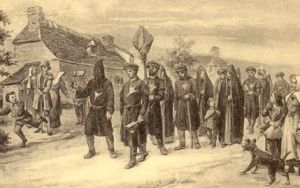 Do you see the goosefoot...? It was a red patch, very nearly a 'scarlet letter,' I'd say... which, by the way, was said to be the letter 'A;' the 'A' shows up again, in association with the Cross of Hendaye... The 'goose-foot' pattern also makes an interesting trident, or stylized fleur-de-lis...  |
|
|
|
Post by Goldenfleeced on Oct 15, 2013 20:34:32 GMT
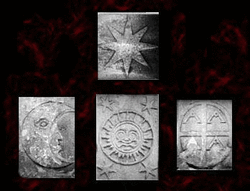 The four sides of the base of the Cross of Hendaye...
1) an eight-rayed star-burst,
2) an oddly shaped half moon with an eye spot,
3) an angry sun face with bulging spiral eyes, dumb-bell shaped mouth and prominent chin. The face of this Sun is framed by 16 large spikes and 16 smaller spikes inside a containing outer circle. The Sun itself is surrounded by four stars, placed in the corners of the rectangle and tilted so that their diagonal axis continues through the center point of the Sun face, effectively drawing a Galactic Cross through the Sun. As discussed below, this is critical. And,
4) an oval that fills the entire space of the rectangle which is quartered by a cross. This oval has four capital letter “A”s in it, with one A on each side of the arms of the cross. The A's are unusual in that they have a sharply angled cross bar nestled in the top angle of each A, rather than the usual horizontal cross bar. www.ascensionnow.co.uk/the-great-cross-at-hendaye.htmlNow, compare that 'A' to this one, which is taken from one of Victor Hugo's sketches made to the 'citadel' in the Pyrenees (the goose-foot)... 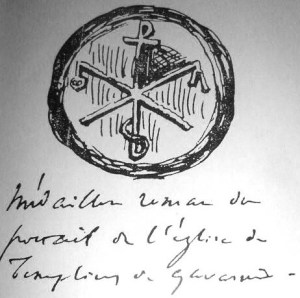
So in the sketch there is a fortification with a religious name and also a religious building that is fortified. The fortified church of the Hospitallers at Luz is known locally as the Templar church, although historians deny that the Templars were ever there. Louis Charpentier in his Mystères des Templiers says that the Templars practised alchemy at Luz.
Eeglise Templies Luz (Remember, 'Luz,' or Lux, means 'Light')
In his sketch Hugo again depicts the church as being higher than the mountains, which is not the case and it is impossible for Victor Hugo to have accessed the observation point from which his sketch appears to have been drawn. Is he using perspective to convey some sort of message? According to some it is supposed to symbolise the way in which human architecture rises from the ground to the sky.So, the goose-foot, the Pyrenees mountains, the language of the birds, the Cross at Hendaye, alchemy and Templars... and, we can throw in Mari, of the Basques, since we have obviously a Chateau of Sainte Marie, don't we? And Mari liked to turn into a little black goat (black virgin, black goat? My friend would wonder if it's really virgin wool... it would necessarily have to be an ugly goat... lol...), from time to time, and wander the mountains... much like a certain scapegoat, I suppose... who carried a message, to those 'outside the camp.' And this little goat is associated also with the Baphomet, the symbol of ultimate spiritual transformation...  |
|
|
|
Post by Goldenfleeced on Oct 15, 2013 21:02:51 GMT
As you will recall, the upper cross's three symbolic components are: (1) the traditional description of INRI on the top of the cross, (2) two double “X” markings, and (3) an oddly broken Latin inscription that reads:
OCRUXAVES
PESUNICA
The meaing of each of these will be dealt with in turn.
First, the “INRI” inscription. The reader will well know that “INRI” is an acronym of the Latin phrase IESVS·NAZARENVS·REX·IVDÆORVM, which translates to English as: “Jesus the Nazarene, King of the Jews.” However, we must remember that Fulcanelli was examining this Cross through the eyes of an alchemist. With this in mind we are placed firmly within the Rosicrucian Alchemical tradition; remember, the Rosicrucians are thought to have had a hand in the creation and establishment of the Cross at Hendaye. As Fulcanelli tells us, within the Rosicrucian Alchemical Tradition, the “INRI” inscription is more likely interpreted as one of the key maxims of alchemy: Igne Natura Renovatur Integra or “By fire nature is renewed whole.” Not only is this phrase important to alchemists, but do not forget dear reader that the Christian world in large part believes that “the end of the world” will be heralded in with the triumphant return of Jesus Christ and the wicked will burn in fire, and then the Earth will be renewed and made whole. (See, e.g., Revelations 17). Could it be that the inscription INRI that hung above the crucified Christ’s head was a tacit acknowledgement that He would return to destroy the world as we know it with fire, and make all things new? Many believe so.
Second, the Double “X”s. To the untrained eye, these markings are simply Xs. However, we must remember that all the parts of the Cross must be examined together. So, these two Xs on the upper Cross—firmly implanted on the symbol of Christ—are full of meaning. Number one, these two Xs symbolize that Christ is, as He is described in Revelation Chpts. 1, 21, 22, “Alpha and Omega,” or, in other words, “the beginning and the end.” Secondly, these two Xs are an effective reminder of the shape of an hourglass—the chief means of time keeping during the era when the Cross was created. What do these hourglasses mean? Fulcanelli believed them to mean several things: one, the time on “the world clock” was running short, even in the 1600’s. Two, the first X symbolizes the beginning of time, or the beginning of the world, and the second X symbolizes the end of time, or the end of the world. The beginning and the end for an alchemist are with fire; thus, Fulcanelli believed that the end would come by fire. Third, when examined in the context of the base symbology (discussed below), these two Xs symbolized the Galactic Cross, Galactic Alignment...www.ascensionnow.co.uk/the-great-cross-at-hendaye.htmlNow, this is interesting... the alchemists' fire, and an hourglass, just as we saw in the woodcut engravings of the 'Ninth Gate' thread. All is vanity... Which reminds me of a Psalm... number 39. 2 I was dumb and spake nothing: I kept silence even from good, and my sorrow was more stirred.
3 Mine heart was hot within me, and while I was musing, the fire kindled, and I spake with my tongue, saying,
4 Lord, let me know mine end, and the measure of my days, what it is: let me know how long I have to live.
5 Behold, thou hast made my days as an hand breadth, and mine age as nothing in respect of thee: surely every man in his best state is altogether vanity. Selah.
6 Doubtless man walketh in a shadow, and disquieteth himself in vain: he heapeth up riches, and cannot tell who shall gather them.
7 And now Lord, what wait I for? mine hope is even in thee.
8 Deliver me from all my transgressions, and make me not a rebuke unto the foolish.
9 I should have been dumb, and not have opened my mouth, because thou didst it.
10 Take thy plague away from me: for I am consumed by the stroke of thine hand.
11 When thou with rebukes dost chastise man for iniquity, thou as a moth makest his beauty to consume: surely every man is vanity. Selah.
12 Hear my prayer, O Lord, and hearken unto my cry: keep not silence at my tears, for I am a stranger with thee, and a sojourner as all my fathers.
|
|
|
|
Post by Goldenfleeced on Oct 15, 2013 21:25:25 GMT
But I digress... somewhat. To continue with the 'cross' for a bit... OCRUXAVES
PESUNICA
Here, it is easy to recognize the familiar phrase: O Crux Ave Spes Unica, which is translated as “Hail O Cross, the Only Hope.” Indeed this inscription is so common as to apparently render the Latin inscription common and of little interest. However, Fulcanelli noticed that this inscription is unique and important because of the misplaced S.
Fulcanelli called attention to the incorrect grammar in the second line. This seemingly “incorrect” grammar gives us the new meaning of the phrase as “measure of the 12th part.” Fulcanelli believed that there was no “mistake” in the grammar, but that the creator of the Cross wanted us to read “measure of the 12th part.” Why? Fulcanelli believed that this phrase is a clear reference to the cosmic cycles and alignments spelled out on the pedestal, the “measurement of the 12th part.”
Fulcanelli opines that the letter S, “which takes on the curving shape of a snake [(note that spes, hope, reversed is seps, or snake)] corresponds to the Greek khi (X) and takes over its esoteric meaning.” Just in case we missed this reference to the key or Cross in the sky made by the X of the snakes or dragons, Fulcanelli informs us “that it is the heliocoidal track of the sun, having arrived at the zenith of its curve across space, at the time of the cyclic catastrophe.” www.ascensionnow.co.uk/the-great-cross-at-hendaye.htmlSo, 'X' is the 'Key'...  Two X's... two keys... Two snakes. And the appearance of a goose-footed queen, I'm sure. Certainly, the interest of the Priory of Sion in this particular area cannot be coincidental. Perhaps the goose-girl is really a shepherdess... lol... And now, to the base... On each of the four sides of the pedestal base a different symbol is displayed. One is the image of the sun; another of the moon; the third shows a great star; and the last a geometric figure, is a simple circle, divided into four sectors by two diameters cutting each other at right angles. Fulcanelli taught that these images constitute a complete hieroglyph of the universe, composed of the conventional signs for heaven and earth, the spiritual and the temporal, the macrocosm and the microcosm, in which major emblems of the redemption (cross) and the world (circle) are found in association.
The Sun, Moon and Stars are globally symbolic for the universe as a whole. In the context of the Cross, the “universe” at issue is the world, the Earth, and its destiny. The real key to deciphering the message that the pedestal base conveys about the “universe” is found by examining the fourth side—the oval quartered by a cross, in which four “A”s are prominently displayed.
It is important to note that in medieval times (the time of the construction of the Cross), there were known to be four phases of the great cyclic period, whose continuous rotation was expressed in antiquity by means of a circle divided by two perpendicular diameters. The four phases were generally represented by the four evangelists or by their symbolic letter, which was the Greek alpha, or, more often still, by the four evangelical beasts surrounding Christ. This traditional formula is often seen on the tympana of Roman porches. Jesus is shown there seated, his left hand resting on a book, his right raised in the gesture of benediction, separated from the four beasts which attend him by an ellipse, called the mystic almond. These groups, which are generally isolated from other scenes by a garland of clouds and always have their figures placed in the same order, are seen in many chapels and cathedrals throughout Europe, including the Church of the Templars at Luz (Hautes Pyrénées).
It is notable that these four quadrants each bear an “A,” which shows that they stand for the four ages of the world. As previously indicated, this is symbolic of nothing more or less than the diagram used to indicate the solar cycle. And why is this important? Because it is this solar cycle upon which the Galactic Cross and precession rest.
In summary, the Cross at Hendaye is a physical representation of the belief by ancient Christians, Rosicrucians, and alchemists that the world’s end is rapidly approaching, and will occur in the midst of fire. As discussed further on these pages, many believe - including Nostradamus, the Bible Code and NASA - that a great comet will pass by, or into, the earth in the year 2012. Many believe that the Cross at Hendaye is just one more reminder that 2012 is the end.www.ascensionnow.co.uk/the-great-cross-at-hendaye.htmlYou see that they give the year 2012 as an 'end date' and we know that it is past... but our calendars and timekeeping methods have been somewhat altered over the years, and I am supposing that it's a give-or-take situation of a few years, as well as the fact that if a certain thing happened in a certain year, and then a certain number more years are required in order to accomplish a certain end which is projected at 'about this time,' then that is taken into consideration in the 'end time' as well... I have my own ideas as to that, given my own projections as to a 'time and times and half a time' that are purely personal, and which I cannot give as a reasonable basis for anything except my own expectations. You are certainly entitled to your own. My own projections would seem to indicate that the time is short... time being relative, of course, and a couple of years being nothing at all in the greater scheme of things; very short, actually. At this time, I would like to quote another poster that goes by the name of 'Spark...' he is evidently a 'firestarter'... lol... who said: IT is coming... Be well. Love much. Shine yer light.And so mote it be, brothers, one and all...  Oh, I have more... Of course, it would be nice to get a response from someone... somewhere... |
|
|
|
Post by Goldenfleeced on Oct 15, 2013 21:44:49 GMT
Here is more... another connection to the Priory of Sion, if you will... lol... So, we know that the document known as 'Le Serpent Rouge' was added to the Dossiers in the 1960's... I have covered this document in other posts on other forums, I know, but due to the timeliness of the content, and the nature, I suppose that it merits another look. We will look at one part here, due to its relevance to the subject at hand, believe it or not... but look, here... My emotions were rising. “Deliver me from the mire!”, I said, and awoke immediately. My dream is over. I have omitted from telling you in effect that this was a dream I had this JANUARY 17th, feast day of Saint SULPICE.
January 17, as we know, is a date that recurs frequently in this Rennes-le-Chateau mystery. It is the day Marie de Blanchefort is recorded to have died, and the date on which Berenger Sauniere fell ill with a stroke, from which he died five days later. It is also the date on which Nicolas Flamel, one of the Grand Masters of the Priory of Sion, is recorded to have successfully completed his first alchemical transformation of base metal into gold, and the date upon which the Priory of Sion‘s “Children of Saint Vincent“ were created. Furthermore, it is, as the poem notes, the Feast Day of Saint Sulpice, and we know that the Priory of Sion took headquarters in the Seminary of Saint Sulpice for some time.
Recently I have discovered even more interesting connections regarding this date. The Birthday Book of Saints, by Sean Kelly and Rosemary Rogers, says that January 17th is also the feast day of St. Anthony the Hermit, the patron saint of buried treasure has cropped up elsewhere in the Rennes-le-Chateau mystery. But even more astounding is that, in addition, this date marks the feast day of “St. Roseline”, whose name contains an obvious connection to the “Roseline” meridian (which, incidentally, runs through St. Sulpice in Paris). According to Kelly and Rogers, she was:
“… the mind reading prioress of Provence. When she was exhumed in 1334, four years after her death, her body was perfectly incorrupt. The astonished cleric in charge was so impressed by the beauty of her eyes that he scooped them out and took them home.”
The details of this story clearly mimic the legend of Venus lying incorrupt within her tomb. The bit about the eyes being taken out connects with the idea of the “Watchers”, and with the story of the missing eye of Horus.
Afterwards, my trouble persisting, I wanted after some reflection to tell you a fairytale by PERRAULT.
Charles Perrault, a seventeenth century French writer and poet, was the author of the book Sleeping Beauty.
www.bibliotecapleyades.net/merovingians/merovingios_renneschateau06c.htmInterestingly, Perrault was also responsible for such 'fairy tales' as Bluebeard, Griselda, and of course, Mother Goose...  Gloryoski... |
|
|
|
Post by Goldenfleeced on Oct 15, 2013 22:08:37 GMT
And, by the way, in a story published in the late 16th century, a man is made to swear 'by the spindle of the Good Queen Pedauque,' which reminds me once again of Perrault's Sleeping Beauty. And, here, also from 'Le Serpent Rouge:' … that the Brothers of the BEAUTY of the black woods, escaping the usurpers pursuing them, disseminated while they were fleeing the white Fort.
If the “beauty” is Isis, or Venus, then her “brothers” are the Cainites (descendants of Cain), who literally were her brothers. Also note that there is a woman whose grave, located on the grounds of the church at Rennes-le-Chateau, is very important to the whole mystery, and whose name, “Marie de Blanchefort”, means literally, “Marie of the White Fort.” Clearly her grave stone, and her name, are clues pointing to the grave of Venus, the real “Marie of the White Fort.”
Reassemble the scattered stones, and work with square and compass to put them back in regular order;
The Freemasons’ most well-known emblem is the L-shaped, right-angled square and compass, and this reassembly of “scattered stones” indicates re-acquiring “that which was lost”, i.e., the Grail stone, by using the L-shaped, right-angled moves of the knight in the Knight’s Tour to “reassemble the scattered stones.”
…search for the line of the meridian that goes from the Orient to the Occident, then look from the South to the North, and finally in every direction to obtain the sought solution, stationing oneself before the fourteen stones marked with a cross.
This indicates using the “Roseline” meridian that, according to the Priory of Sion and Pierre Plantard, runs through Rennes-le-Chateau, and which is a much more ancient meridian than even the Paris meridian, supposedly. It has been suggested that the “fourteen stones marked with a cross” may actually refer to the fourteen Stations of the Cross within the church, each of which is surmounted by a Celtic-style cross with a circle. However, I am not certain that this is the correct interpretation.
The circle was the ring and the crown, and that was the diadem of this QUEEN of the castle.
This passage associates the Venus figure with the written symbol of Venus: a cross surmounted by a circle - the queen crowned. This sign is related to the Celtic cross mentioned above, and to the Egyptian Ankh, which was also used by the Cathars, who referred to it as “the Albigensian cross.” This imagery may further be related to that of the constellation Virgo, who is depicted in iconography as crowned with a circle of stars, as are Isis and the Virgin Mary.
The stones of the mosaic pavement from the sacred place are alternately white or black, and JESUS, like ASMODEUS, observes their alignments.
This again is the black and white chessboard tiling on the floor of the church at Rennes-le-Chateau, which both the statues of Jesus and Asmodeus are staring down on. Perhaps we are meant to observe the alignment of the chessboard with other items in the church, and/or to project these alignments outward through the wider surrounding landscape.
My view seemed incapable of seeing the summit where the Sleeping Beauty lay hidden.
Again, we have a reference to the goddess buried within the mountain: the Venusberg tale, upon which the story of Sleeping Beauty is based.
It is not by the magical strength of HERCULES that one deciphers these mysterious symbols engraved by observers of the past.
This is a reference to the cave known as the Tomb of Hercules (a.k.a Enoch), which is covered with hieroglyphic symbols, just as the tomb of Hermes (Enoch) supposedly is.www.bibliotecapleyades.net/merovingians/merovingios_renneschateau06c.htmNotice the underlined part, just above, and recall what was said about Hugo's sketch of the 'church'... and GL has the meaning of 'mountain'... Black Virgin, Black Ibis, Black Swan... I hope the brothers are all 'squared away'... lol... |
|
|
|
Post by Goldenfleeced on Oct 15, 2013 22:41:01 GMT
Not only did Victor Hugo sketch the church, he studied it attentively, making sketches of the stone carvings (see figure above), asking for historical details and making sure he was using the correct vocabulary for the architecture. He was highly interested in the epitaph on the tiny sarcophagus of a child let into the wall and dating from 1236. “I stopped at a tomb with the inscription worn away by time. I nearly deciphered the last line.”
He was most frustrated that he could not make out the dialect in which it was written. He did not seem to accept that it was simply the signature of the sculptor from the neighbouring village of Sère.
The epitaph reads: -
AQ IAHS …… O ………
BAT FILLA DENERAMO DE BARE
LA E MADAUNA O NAHERA MCC.XX
X.V.I.ANO EMORI EN LA DAHERA SETMA
NADABRIL GUIL. DE SERA LOFE
Here lies Benoîte daughter of M (the prefix d’en, d’En or Na were marks of distinction) Aramon of Barège and of Madame Nahera 1236 died in the last week of April. Guilhem de Sère made it.
In 1213 in an act of cession by the Hospitallers of Gavarnie to the Templars of Monzou in Aragon, mention is made of a Guilhem de Sers who was the Prior of the Hospital at Gavarnie and also of a Guilhem de Sère who was a brother.
Victor Hugo seems to have paid scant attention to the Brèche de Roland carved according to legend by Durandal, the trusty sword of Roland the companion of Charlemagne, preferring instead to visit the church of Gavarnie where he made a sketch of the chrisme above the door. And, among the symbols, we have our 'black and white squares'... Which reminds me of another 'headstone' of interest... that of Marie de Blanchefort... at Rennes. Just coincidentally...
|
|
|
|
Post by Goldenfleeced on Oct 19, 2013 2:06:29 GMT
Now, I would just like to quickly add a couple of points to this discussion, that also seem pertinent, under the circumstances... St. Ignatius of Loyola was from... Loyola... which lies firmly in the heart of the Spanish Basque country, and we all know some of his history, at least... St. Ignatius Loyola was born in 1491, one of 13 children of a family of minor nobility in northern Spain. As a young man Ignatius Loyola was inflamed by the ideals of courtly love and knighthood and dreamed of doing great deeds.
But in 1521 Ignatius was gravely wounded in a battle with the French. While recuperating, Ignatius Loyola experienced a conversion. Reading the lives of Jesus and the saints made Ignatius happy and aroused desires to do great things. Ignatius realized that these feelings were clues to God’s direction for him.
Over the years, Ignatius became expert in the art of spiritual direction. He collected his insights, prayers, and suggestions in his book the Spiritual Exercises, one of the most influential books on the spiritual life ever written. With a small group of friends, Ignatius Loyola founded the Society of Jesus, or the Jesuits. Ignatius conceived the Jesuits as “contemplatives in action.”
- See more at: www.ignatianspirituality.com/ignatian-voices/st-ignatius-loyola/#sthash.wkvl5b2m.dpufI like that last line... lol... Now, we also know that the good St. Ignatius spent many hours of prayer before the 'Black Virgin' of Montserrat... On the mountain named Montserrat, near Barcelona, in the Catalonia region of Spain, a church now contains a 'miracle- working' statue of the Madonna and Child known as La Moreneta, that is: the dark little one.
Legend relates that the miraculous image was first known as La Jerosolimitana (the native of Jerusalem), since it is believed to have been carved in that city during the early days of the church.
Another account, seemingly well-attested, indicates that the image was moved to Montserrat in 718, to avoid the danger posed by invading Saracens. The image disappears from the historical record at this point, to reappear in a legend holding that shepherds found the lost statue under supernatural guidance in 890:
While tending their flocks that night the shepherds were amazed to see lights and to hear singing coming from the mountain. When this was repeated, the shepherds reported the situation to their priest, who investigated. When the priest also heard the singing and saw the mysterious lights, he informed the Bishop, and he also witnessed the phenomenon. The statue of Our Lady was discovered in a cave and was brought out and placed in a small church that was soon erected.
However, the statue presently kept at the Montserrat shrine [at left] appears to have been introduced in the twelfth or thirteenth century. Its Romanesque style is consistent with this estimate. Beyond general style, the genre of the statue is certainly that of an 'enthroned virgin', typical of the earliest icons of Mary. On behalf of Madonna and Child representations, Stephen Benko notes:
"It is well known that the iconography of Isis and [her son] Horus was basically adopted by Christians when they started to portray Mary and Jesus as Mother and Child."
Benko adds that Isis was sometimes "pictured as black." These observations indicate only a correlation, not a causal relationship. They do not answer the question why the Montserrat figures are black. Perhaps a lost statue of Isis was located by ninth-century shepherds and assumed to be a Madonna and Child, in spite of the dark features.
The present copy could have reproduced the general style with adaptations to accommodate Romanesque taste. However, no less likely is the theory that the present copy was modeled on the Christian genre of the enthroned Virgin. Why then the black color of the figures?
Perhaps it was done in imitation of earlier Christian Black Madonnas which the sculptor had seen. This sounds plausible, but is unsupported by hard data. Perhaps, it was inspired by the commentaries on the Song of Songs ["I am black but beautiful"] which were popular at that time. Again, we have no evidence of this beyond the temporal coincidence of events. On the negative side, Montserrat is located in Spain, not in France where St. Bernard of Clairvaux and others produced well-known commentaries on the Canticles. Perhaps the image was created black to represent some esoteric religious symbolism. Ean Begg notes that the Shrine of Montserrat is among the best candidates for former sanctuaries for the Holy Grail. Further, in the twelfth and thirteenth centuries esoteric Christian sects proliferated, though not primarily in Spain. Again, these are correlations, not proofs... Perhaps Cruz is right:
In any case, certain facts may not be disputed. The statue has always been considered one of the most celebrated images in Spain. However, like Our Lady of Einsiedeln in Switzerland, its popularity is limited to a regional rather than a universal scope. Also, the shrine has received innumerable pilgrims over the years, currently at the rate of at least one million per year. This multitude includes secular and ecclesial rulers as well as a number of canonized Saints. The most notable of these was St. Ignatius of Loyola, who laid down his sword and embarked on his religious mission "after spending a night praying before the image," a miracle in the order of grace. campus.udayton.edu/mary/meditations/olmont.htmlSo, about the 'Jesuits'... and the Templars... and a little bit of 'romance'...  |
|
|
|
Post by Goldenfleeced on Oct 19, 2013 2:21:12 GMT
The Conversion of St. Ignatius During the long weeks of his recuperation, he was extremely bored and asked for some romance novels to pass the time. Luckily there were none in the castle of Loyola, but there was a copy of the life of Christ and a book on the saints. Desperate, Ignatius began to read them. The more he read, the more he considered the exploits of the saints worth imitating. However, at the same time he continued to have daydreams of fame and glory, along with fantasies of winning the love of a certain noble lady of the court, the identity of whom we never have discovered but who seems to have been of royal blood. He noticed, however, that after reading and thinking of the saints and Christ he was at peace and satisfied. Yet when he finished his long daydreams of his noble lady, he would feel restless and unsatisfied. Not only was this experience the beginning of his conversion, it was also the beginning of spiritual discernment, or discernment of spirits, which is associated with Ignatius and described in his Spiritual Exercises.
The Exercises recognize that not only the intellect but also the emotions and feelings can help us to come to a knowledge of the action of the Spirit in our lives. Eventually, completely converted from his old desires and plans of romance and worldly conquests, and recovered from his wounds enough to travel, he left the castle in March of 1522.
Ignatius' mule decides whether or not to pursue the MoorHe had decided that he wanted to go to Jerusalem to live where our Lord had spent his life on earth. As a first step he began his journey to Barcelona. Though he had been converted completely from his old ways, he was still seriously lacking in the true spirit of charity and Christian understanding, as illustrated by an encounter he had with a Moor on his way. The Moor and he came together on the road, both riding mules, and they began to debate religious matters. The Moor claimed that the Blessed Virgin was not a virgin in her life after Christ was born. Ignatius took this to be such an insult that he was in a dilemma as to what to do. They came to a fork in the road, and Ignatius decided that he would let circumstances direct his course of action. The Moor went down one fork. Ignatius let the reins of his mule drop. If his mule followed the Moor, he would kill him. If the mule took the other fork he would let the Moor live. Fortunately for the Moor, Ignatius' mule was more charitable than its rider and took the opposite fork from the Moor. Ignatius offers himself and his sword to God
He proceeded to the Benedictine shrine of Our Lady of Montserrat, made a general confession, and knelt all night in vigil before Our Lady's altar, following the rites of chivalry. He left his sword and knife at the altar, went out and gave away all his fine clothes to a poor man, and dressed himself in rough clothes with sandals and a staff. norprov.org/spirituality/lifeofignatius.htmThe references to a 'Moor' and being insulted are also quite interesting... the first, because the 'King's daughter' in the story of the 'Chemical Wedding of Christian Rosencruez' is kidnapped by a 'Moor,' and the second, because the Basques are known to respond poorly to insults; some of them have been known to never speak to a person again (for their lifetime) after having perceived such an insult. Now, this reaction may seem a bit extreme, on first thought, since the New Testament teachings urge us to forgive others... nevertheless, it is also written that there is one 'sin' which will not be forgiven men, and that is the 'insults' to the Holy Spirit. It would also seem that the Basques love to dance... they are extreme;y strong for their size... and insistent upon the discharge of 'duty.' The firstborn is the family heir, whether male or female. And one more interesting thing... the doors of their homes are 'low'... As was the strange door to the church. And, oh, yes... they are shepherds.  |
|
|
|
Post by Goldenfleeced on Oct 19, 2013 2:58:09 GMT
See the sphere that she is holding? It reminded me of something... look at this... The stone spheres (or stone balls) of Costa Rica are an assortment of over three hundred petrospheres in Costa Rica, located on the Diquís Delta and on Isla del Caño. Locally, they are known as Las Bolas. The spheres are commonly attributed to the extinct Diquís culture and are sometimes referred to as the Diquís Spheres. They are the best-known stone sculptures of the Isthmo-Colombian area.
The spheres range in size from a few centimetres to over 2 metres (6.6 ft) in diameter, and weigh up to 15 tons. Most are sculpted from gabbro, the coarse-grained equivalent of basalt.en.wikipedia.org/wiki/Stone_spheres_of_Costa_Rica |
|
|
|
Post by Goldenfleeced on Oct 19, 2013 3:51:26 GMT
What you will read from here on are ideas that you will not find in the usual sources of information. What if the CRBs were ancient power receivers? This writer has established, in previous articles, the possible existence of a prehistoric/worldwide Tesla system used by the descendants of the Atlanteans. The ancient monoliths, pyramids, stone circles and grand statues were not just art or architecture. They were the Utility Poles of the Gods. Wireless, power distribution is the key to understanding the pyramid civilizations. All we need is a stone, (crystalline) ground contact to tune in the power. Functioning like tuning forks, the stones vibrate or relay the EM world frequency. The Costa Rican Balls are all we need, in a cityless region, to expand the World Wireless; so that communications remain intact; so that ancient aircraft remain powered, etc.
The pyramids have astronomical and power-grid alignments. The ancient, stone circles have this grid pattern. The American mound-builders constructed mounds (in a pattern) around the main complex at Cahokia. In Africa, smaller Zimbabwes were built surrounding the central/stone complex. The spheres in Costa Rica could fit the pattern where their original locations truly had a significance. Remember the Olmec and their creations of (rounded) African stone-heads? In Vera Cruz, these spherical heads weighing many tons were discovered; isolated in the jungles and far from their quarry. The same purpose of relaying an EM wireless frequency could explain both the Olmec heads and the Costa Rican Balls.
In the modern stone-art known as lapidary, it is very difficult to make a perfect sphere that is 2 feet wide. To manufacture spheres out of a hard substance that is 6, 7 or 8 feet in diameter...is building on a scale above what we can accomplish today. For the ancients, it was child's play.
Sadly, CRBs are no longer unearthed on a regular basis like they were decades ago. New technologies such as ground penetrating radar may reveal more in the future. One last thought for those of you wondering about the wireless-energy explanation to the Costa Rican mystery.....The general shape of the top of an antenna: is a ball.www.world-mysteries.com/sar_crb_doug.htmAnd the fact that she holds one of these spheres might mean, what...? That she 'communicates' with them... maybe... An heir to a kingdom... maybe...
|
|
|
|
Post by ayraman on Oct 20, 2013 22:51:44 GMT
See the sphere that she is holding? It reminded me of something... look at this... The stone spheres (or stone balls) of Costa Rica are an assortment of over three hundred petrospheres in Costa Rica, located on the Diquís Delta and on Isla del Caño. Locally, they are known as Las Bolas. The spheres are commonly attributed to the extinct Diquís culture and are sometimes referred to as the Diquís Spheres. They are the best-known stone sculptures of the Isthmo-Colombian area.
The spheres range in size from a few centimetres to over 2 metres (6.6 ft) in diameter, and weigh up to 15 tons. Most are sculpted from gabbro, the coarse-grained equivalent of basalt.en.wikipedia.org/wiki/Stone_spheres_of_Costa_RicaSo I was thinking about these being some sort of healing/cleaning device. Probably to dampen the electro static air that would surround us if we were to go wireless power via say a pyramid powerplant and an obelisk. To talk all crazy. Anyway you can hold a small one in your hand and it would absorb any electro/magnetic disturbance in your force to go all Yoda speak. The larger ones would serve as large collectors. They probably would then decorate the larger ones with maps because if there there anyway they might as well be art too. Right? LOL Basalt collect carbon dioxide. Check this crazy notion from a 2008 WIRED article: Scientists may have discovered the closet where we can hide the mess that burning fossil fuels creates. Many have viewed "carbon sequestration" — taking the CO2 produced by burning coal and burying it underground — as a major component of combating climate change. However, there are many questions about the plan — most notably, just where a major emitter like the US could find a safe place to stash gigatons of carbon dioxide safely over hundreds of years. The answer, say Columbia researchers, lies in huge reservoirs of basalt off the coast of the Pacific northwest. That basalt is buried underneath hundreds of feet of sediment, and that in turn lies thousands of feet below the ocean’s surface. The basalt, located on the San Juan de Fuca tectonic plate, could store about 150 years’ worth of the United States’ yearly load of 1.7 gigatons of emissions. www.wired.com/wiredscience/2008/07/scientists-map/gizapower.com/Articles/return.html |
|
|
|
Post by ayraman on Oct 20, 2013 22:57:50 GMT
|
|




